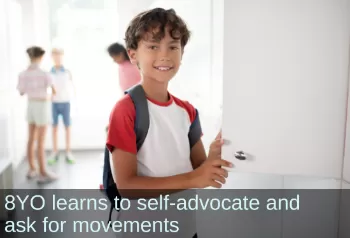Primitive Reflex Integration Case Studies
Boy with Autism and ADHD Gains Better Focus and Body Awareness in 6 Weeks
Program of rhythmic movements and primitive reflex integration improves proprioception, impulse control, and attention in the classroom.
This 8-year-old boy had poor body-spatial awareness, often tripping or accidentally running into people, and challenges paying attention. His OT provided rhythmic movements and reflex integration from the Brain and Sensory Foundations course, and in 6 weeks saw improvements in all areas. He also started self-advocating and letting adults know when he needed regulation support!
Submitted by Danielle Hicken, OTR/L

| Before | After |
|---|---|
| Challenges self-regulating | Advocating for himself to his teacher and BCBA to express when he needs calming movements or a hug |
| Challenges paying attention in class; often getting out of his seat to walk around | Attention in the classroom is improving |
| Poor spatial and body awareness; often accidentally running into classmates | Running into his peers less |
Client is an 8-year-old boy with Autism and ADHD diagnoses. His challenges include spatial awareness, body awareness, balance, impulse control, and attention in the classroom. He often runs into classmates accidentally, trips/falls, and gets out of his seat to walk around.
Client demonstrated active Tonic Labyrinthine Reflex, Asymmetric Tonic Neck Reflex, Fear Paralysis Reflex, Moro, and Spinal Galant. I started with passive Rhythmic Movements [from the Brain and Sensory Foundations course] because I knew that starting here would indirectly establish a solid foundation for reflex integration as well as help with integrating FPR and Moro. When we started with RM #1, the client immediately became stiff and developed a flushed face. These signs told me to stop (after approximately 5 seconds). We engaged in [movements] in supine, which he enjoys and which I knew would help him regulate. He was able to tolerate RM 2, 3, and 4 without discomfort. I asked mom to start completing RM 2, 3, and 4 at home–she came back the next week reporting that these caused him to fall asleep within 5 minutes. After a couple weeks, we slowly re-introduced RM 1 which resulted in decreased tension and facial flushing. I also used the Brain Tune up to help with focus in the classroom and consulted with his teacher to ensure correct implementation.
For 6 weeks, he came to weekly sessions, his teacher used the Brain Tune up [from the Brain and Sensory Foundations course] and his classroom BCBA was able to pull him out and perform rhythmic movements. Mom continued to complete the rhythmic movements at home before bed.
By the end of the 6 weeks, the client was advocating for himself to his teacher and BCBA, telling them when he needed exercises or a big hug! His teacher reported that his attention in the classroom was improving, and he was running into his peers less. His mom said I should use their example as encouragement for all families to be consistent with their exercises.
I learned that you’re never too young to learn to self-advocate, and that progress can happen quickly with consistency and carryover!
(Edited, emphasis added)
*Disclaimer: The activities in the Brain and Sensory Foundations curriculum make use of the natural processes of neuroplasticity and development that are innately wired in the design of human beings to promote maturity and function. These activities appear to calm, organize, and mature the neuro-sensory-motor systems just as we see in the healthy development of human infants. Individual results may vary, and we do not claim to offer a diagnosis or cure for any specific condition or disorder. The Brain and Sensory Foundations activities appear to improve overall functioning resulting in measurable improvements for a range of conditions as demonstrated in over 1800 case studies from participants.

